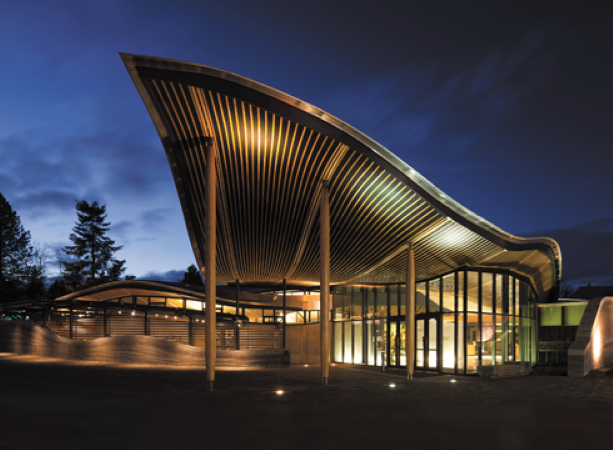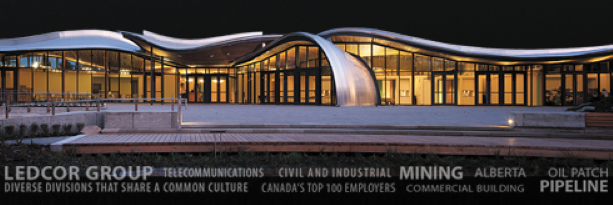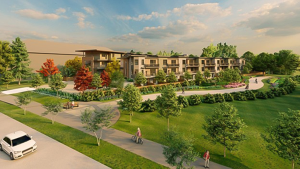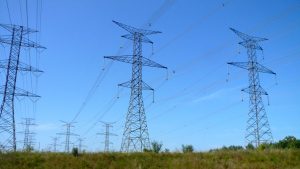The Ledcor Group of Companies is composed of diverse divisions that share a common culture. That culture consists of far more than just a series of slogans posted on a boardroom wall. It influences the performance of each employee, guides the selection of each partner and subcontractor and determines the projects on which the company will bid.
The Ledcor Group of Companies is composed of diverse divisions that share a common culture. That culture consists of far more than just a series of slogans posted on a boardroom wall. It influences the performance of each employee, guides the selection of each partner and subcontractor and determines the projects on which the company will bid.
The company’s roots were planted in the Alberta oil patch with William Lede who founded the Leduc Construction Company in 1947, in the town bearing its name. The town’s significance? It was located a stone’s throw from Imperial Oil’s discovery of prolific reserves of conventional oil that began the Alberta oil boom. The company prepared both the access road and well site for the oil discovery.
Ledcor capitalized on its initial success with an expansion into heavy civil construction projects that included highways, dams, airstrips, gravel crushing, mass excavations and rock blasting.
By the 1970s, a pipeline division was established to help move the province’s resource riches to waiting markets. With winter pipeline construction balancing out the seasonal construction work, equipment utilization rates soared.
Mine work, both metallic and non-metallic, began in the early 1980s in markets as diverse as Ontario, British Columbia and Nevada.
PHOTO INSET: NIC LEHOUX
The construction of Calgary’s Bow office tower is a notable project on Ledcor’s resume.
After a strategic review in the early 1980s, the company continued to expand under six divisions: Commercial Building, Heavy Civil, Industrial, Mining, Pipeline and Telecommunications. Each division operates with a degree of autonomy while supporting the others. Management teams meet frequently across divisions to cross-pollinate ideas and approaches while opening new lines of communication.
As an employee-owned company, a share purchase program is offered to employees before their three years of service. For 2013, the company has been chosen as one of Canada’s Top 100 Employers. In 2012 it was named in the Financial Post’s Ten Best Companies to Work For and among B.C.’s Top Employers.
Peter Hrdlitschka, Ledcor’s president of Western Canada construction, joined the company in 1991 with a wealth of experience in multi-unit residential and commercial construction.
“It was an opportunity to grow that side of the business from the ground up, at a time when Ledcor was looking to increasingly diversify from civil and industrial work,” says Hrdlitschka. “I was located in Vancouver and that’s where the company moved its new office devoted to that sector.”
Residential condominiums and shopping centres formed the bulk of the company’s work at that time, part of a construction boom spurred by Expo ‘86.
“The condominium work eventually prevailed so that we built residential high-rises for three or four years straight, almost exclusively,” he says. “So much so, that at one point, we were asked if we could recommend someone to work on a shopping centre. We were diversified, but we’d been so engaged in the condominium boom that people had forgotten what we could do.”
Today, the division is almost exactly balanced between office, commercial, condominium and institutional projects. It’s a balance Hrdlitschka likes and one achieved through a careful project selection process.
“The first thing we look at is our national account strategy, which focuses on developing lifetime clients,” says Hrdlitschka. “About 60 per cent of our work is completed on behalf of repeat clients. Companies with a national presence will always be here and they’re the ones who have helped us to grow our business. We’re also open to developing new relationships with a view to the long term.”
Subcontractors are likewise chosen according to three strict criteria — price, performance and an ability to step up to the plate to serve clients operating on the national scale.
Hrdlitschka cites a trio of diverse projects as most representative of the division’s strengths.
Ledcor was the contractor on Calgary’s Bow office tower, a project valued at $1.4 billion.
“It’s a massive project and one where everything from the selection of the team, to the choice of subcontractors is reflected in the way we’re handling the project,” says Hrdlitschka. “We had our civil division do some of the site preparation with workers coming in from the industrial group to do the concrete forming. It demonstrates how the company divisions support each, with both expertise and human resources.”
The division has also successfully undertaken work on the Lynden Pindling International Airport in Nassau, The Bahamas.
“This is the division’s first international contract, a three-phase construction project,” says Hrdlitschka. “Vancouver’s YVR manages the airport and I knew a few people there. When I heard about the contract I thought of it as out of the area, but then decided to bid the first phase. We started work in 2008 and negotiated the final two phases. We sourced subcontractors from Florida, Toronto and Vancouver and used mostly local labour. It’s a great demonstration of the fact that project management expertise is what we bring to the table.”
Hrdlitschka also cites the VanDusen Botanical Garden Visitor Centre in Vancouver, the first Canadian project to aim at meeting the principles of the Canada Green Building Council’s Living Building Challenge.
“Not only is it carbon neutral and water neutral but we had to source all materials from within a certain radius of the building site,” he says. “We couldn’t use a valve made in China, for example.”
The division expects to see continued growth over the next five years. “Not exponential growth, but steady and solid,” says Hrdlitschka.
Tom Lassu is president of Ledcor’s contractors division, one of the company’s largest. Lassu first worked summers for Ledcor in 1981 as a flagman on Alberta and British Columbia road paving projects.
Since then, he’s successfully solidified Ledcor’s presence in the industrial construction and maintenance field.
“It’s challenging work offering high risks and rewards,” says Lassu. “There’s an adrenalin that goes along with this business.”
Like his counterparts in the company’s other divisions, Lassu lives and breathes company culture.
“In order to keep these long-term clients we value, we need to stick with our core values to maintain the reputation for hard work, value and integrity that we’ve developed over the years,” he says. “If we’re not aligning with clients who value what we value, it creates confusion and mixed messages that can impact not only the quality of work but the safety of our employees. We’ll pass on revenue opportunities if we don’t believe that a client is setting us up for success.”
Lassu’s division is currently involved in the South Fraser Perimeter Road project, a massive P3 undertaking that includes construction work costing $658 million. Located in Delta and Surrey, B.C., the 34-kilometre, four-lane roadway project will be completed by the group, which includes ACS Infrastructure Canada Inc. and Ledcor Industrial/Mining Group Ltd. as equity partners, and Dragados Canada Inc., Ledcor CMI Ltd., BelPacific Excavating and Shoring Limited Partnership and Vancouver Pile Driving Ltd. as members of the design-build team.
“With a piece of the equity, we will also own, operate and maintain the roadway,” says Lassu. “It’s a very significant project in our portfolio. All of the partners have similar philosophies and are driven by a drive for quality and safety, rather than price. We’re investing the effort to ensure that our philosophies mesh across company cultures.”
At the same time, the division has completed more than two decades of work for Barrick Gold Corporation in Nevada, in a three year-rolling contract. “That’s 24/7 for 20 years straight,” says Lassu. “The work includes support for mining of ore and processing of materials at Cortez and Goldstrike. It’s been a very successful contract for us.”
The division currently fields an average of 250 people assigned to a contract working on the Enbridge pipeline system to ensure safety and reliability of the system. “We started in 2011 and the repair and construction work presents a significant contract,” says Lassu. “Pipeline repair and maintenance work represents an increasing portfolio for us.”
Lassu’s division is also more heavily invested in the Fort McMurray, Alta. area, after entering that market about five years ago.
“We’re involved in everything from roadway construction and maintenance, to mass excavation, bridge building and foundation and piling work,” says Lassu. “In this market, we’re enjoying three- to five-year rolling contracts and transitioning ourselves from primarily new construction to sustainable work that includes helping to keep plants running and feeding materials into processing plants. That levels out the revenue stream through construction troughs, and gives us better insight into the future and more confidence to invest in training.”
These contracts also pave the way for future commercial construction. Hrdlitschka’s division is fielding an increased presence in the area as populations continue to grow. His division is handling the Fort McMurray Airport Expansion, for example.
“Once the people arrive, the need for a Tim Hortons outlet soon follows,” says Lassu.
As part of its drive to diversify, Ledcor has also expanded into forestry and transportation.
In forestry, Ledcor covers the entire supply chain, including everything from selling logs to saw mills and pulp facilities, to processing logs into cants, chips and hog fuel.
Those efforts complement the company’s increasing presence in the transportation sector. Ledcor delivers wood fibres and pellets in the B.C. Lower Mainland on a series of tugboats and barges to take advantage of co-generation opportunities. In northern Canada, the company has established a toehold in the air transportation business, allowing it to provide logistics support for more remote projects. Ledcor owns two airlines offering remote services to Canada’s north, has a stake in a fractional jet ownership company and is a partner in the Vancouver Harbour Flight Centre seaplane terminal, which the company built.
With Ledcor’s engagement calendar currently filled with a record number of projects stretching up to five years into the future, the company finds itself in an enviable position.
“However, we didn’t get there because we’re the greatest bunch of executives,” says Hrdlitschka. “We try to develop a team atmosphere, and provide our employees with the support they need to do their jobs well. Given autonomy to do their best, they’re delivering results.”
High-profile projects
The roots of the Ledcor Group of Companies were planted by William Lede in 1947 with his Leduc Construction Company. Since then the company has continued to expand with success under six divisions: commercial building, heavy civil, industrial, mining, pipeline and telecommunications. Their work includes the following projects of note:
■ Calgary’s Bow office tower
This project, valued at $1.4 billion, is a massive, award-winning project, which saw the company’s civil division do some of the site preparation with workers coming in from its industrial group to do the concrete forming.
■ Lynden Pindling International Airport
This project resulted in the largest airport in the Bahamas being built in Nassau. This was a three-phase construction project in which the company started work in 2008.
■ VanDusen Botanical Garden Visitor Centre
This Vancouver area project is one of the first Canadian projects aimed at meeting the principles of the Canada Green Building Council’s Living Building Challenge.
■ South Fraser Perimeter Road project
This 34-kilomtere, four-lane roadway project is a massive P3 undertaking which includes $658 million in construction work. It is located in Delta and Surrey, B.C.

1/3
2012 Leaders
2/3












Recent Comments
comments for this post are closed